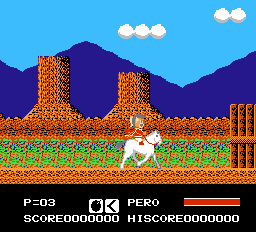 ... ...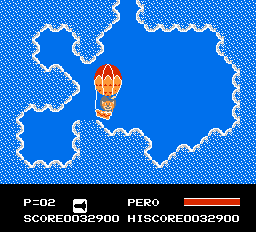
Puss N Boots: Pero's Great Adventure is a game that would have come and gone and completely dropped off the radar into the depths of gaming obscurity if not for a certain wealth of weirdness that surrounds it.
The game was based on an anime from 1976 called Puss in Boots Travels Around the World, which in turn was the third (and last) in a series of Puss in Boots movies that began in 1969. None of these movies had yet seen American shores, but someone was darn well determined to make sure we'd know who Pero, the feline protagonist, is because the game was heavily advertised in Nintendo's Comic System from the early 90's and it has the honor of being the single most obscure game to ever have an entire episode of the NES-themed cartoon Captain N: The Game Master based on it.
So, at this point we have a cartoon based on a game that was based on an anime that was the second sequel to a movie based on the famous Puss in Boots story by author Charles Perrault (whom Pero is named after), and we even have some of Jules Verne's Around the World in 80 Days thrown in somehow. Whew.
 ... ...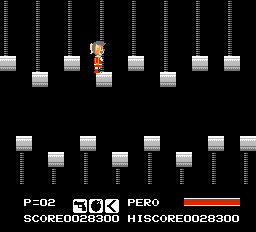
All of the hype and hoopla surrounding Puss N Boots makes the actual game all the more jaw-dropping in its mediocrity. In perhaps skewing for a younger audience, the developers aimed way below the mark, with level design dominated by long stretches of walking or riding in a vehicle with absolutely no enemies, bottomless pits, or onscreen dangers of any kind. (In the rare cases when these things do appear, they are easily surmounted.) The entire game can be beaten in less than 15 minutes, with the only possible impediment being a final boss that is disproportionately difficult.
Puss N Boots, like the movie it was based on, follows Pero's adventures as he travels around the world, starting in the Old West, then moving to Arabia and Europe, and eventually ending in New York. A time travel plot was tacked onto the American version, but it doesn't matter since it's only in the manual (and the Captain N episode), and there is no actual evidence of time travel or any time machine in the game itself.
What there is evidence of, however, is a complete lack of understanding on how to make a video game on the developer's part. As Pero moves (on foot or in vehicle) from left to right, you occasionally jump over something or shoot at something. Sometimes enemies will apppear in groups and might seemingly pose a threat, but then they get caught on background objects and bounce themselves off the screen before they're anywhere close to you. Other times, enemies appear in places where they won't likely be in your path at all. Some enemies take more than one hit to kill, and could possibly ram you if you didn't destroy them in time... except that when they get too close, they make your life easier by jumping over you, even if it's a damn pirate ship!
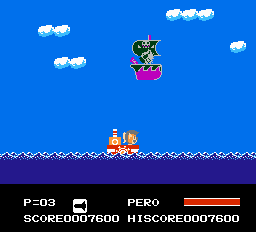
I wouldn't ask you to believe it if I didn't have the evidence right there, but yes, pirate ships can jump in this game...quite loftily, too. All in the name of facileness.
The game's weirdness doesn't even begin or end there. It can be a real contest to decide if the hype that surrounded the game was weirder or if the game itself is. There are, for example, balloon-like disembodied heads for enemies in several of the levels. Why..? The trip to London culminates in an ascent up Big Ben (despite the fact that the Statue of Liberty level actually has gears in the background and Big Ben doesn't), and who should the boss at the top be?

Pazuzu. Makes perfect sense.
The biplane level (which I firmly believe is possible to beat with your eyes closed) contains several anomalies, including a cheeseburger floating in midair and an eagle that attacks by pooping on you.
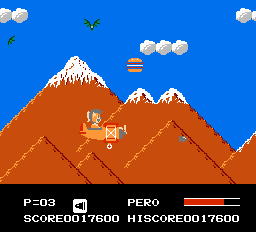 ... ...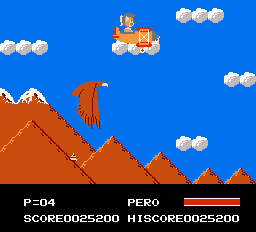
I normally would not be taken aback by the existence of a cheeseburger power-up in a video game, but when it's the only cheeseburger in the entire game, then it seems weird for it to be floating in the sky. I am also quite certain that this is the only American-released NES game in which I have (so far) witnessed the act of defecation by any of its characters.
There are other strange things that just don't seem right about this game, including a flying pagoda boss (considering M.U.S.H.A., maybe this game was ahead of its time), a car that, with no discernable hydraulic system, can jump higher than Sophia the 3rd from Blaster Master, and lightning bolts that can actually be destroyed by a bullet. Not to mention that the background designer seems to have confused St. Bazil's Cathedral with the Taj Mahal.
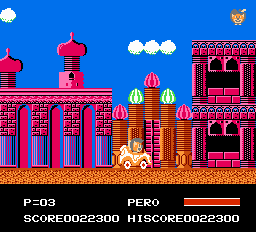 ... ...
Strangest of all is the situation regarding the game's final boss. Composed of two different villainous characters from the cartoon, a wolf named Dr. Gari-Gari and a pig named Count Gruemon (who looks an awful lot like the Poltergeist King from The Real Ghostbusters), they materialize with no warning, and move so fast and fire so many bullets, that it is very easy to be annihilated by them within seconds of entering their room. There is a way to beat these guys, but their movement patterns are somewhat-random, so luck plays a small role. I'm not complaining about the boss being hard, but it does make me wonder why they were made this difficult considering every measure was taken to neuter the rest of the game.
 ... ...
While the vehicle stages are barren, the walking stages have no shortage of background objects, which is why it's so peculiar that they look amateurish. The drabness is augmented by the arrangement of buildings, et al, into block patterns with obvious right angles. In contrast, the music is profoundly competent, with the highlight being a rockin' "Game Over" theme. The soundtrack was composed by Mitsuyasu Tomohisa of the popular Japanese rock band, Jaywalk. By now, it's seeming like more budget went into the music and the advertising than the game itself.
The weirdness of Puss N Boots is reminiscent of another quirky NES sidescrolling game, Kid Niki: Radical Ninja, except I understood why that game was weird. The oddities in and around Puss N Boots are more boggling in their abstractness because I do not understand what goal the game was trying to achieve in the first place. If this was some sort of flagship effort to introduce Pero to American audiences, then why not just have given us the movie instead?
Score: 1.5/5
|